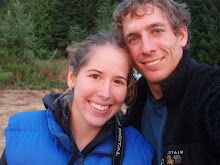Rope spaghetti in action:
The Basics
(1) It's almost always worth the extra time to organize your ropes. The time saved not having to undo a knotted rope is important.
(2) When you have 2 followers (especially if you're belaying both on a reverso), separate the ropes as you bring them up. Whoever has to lead next with both ropes will thank you for not getting short-roped the entire pitch.
(3) Take care to keep your leash (clove-hitched end of the rope and/or your daisy chain - basically your attachment point to the anchor) away from the ropes you pull up and the leashes of your follower(s). You don't need to put to much brainpower into belaying, so as you do, think about where to direct your follower(s) when he/she/they arrive. Usually you want your leash(es) to be on top of everything and the followers to be underneath everything.
The Giant Ledge Belay
This is the easiest situation - you have a nice, big ledge with plenty of room to flake your rope(s) onto the ledge. If you have 2 ropes, put them in separate piles. If you are leading the next pitch, remember to "pancake flip" the rope pile(s) - just pick up the whole thing and flip it upside down.
Alex Pelman and I enjoying a huge ledge low on North Early Winter Spire (North Cascades - Washington Pass):

The Small Ledge
This starts to get complicated. Sometimes you reach the anchor and you have a ledge, but a small one. Sure, you could just flake the rope onto the ledge on top of your feet, but what if you have 2 ropes? And then where are the follower(s) going to stand? This is where the stacked lap coils come in. Luke and I use this all the time and it works really well. It deserves it's own section, so keep reading to find out more!
Alex Pelman and I keeping the ropes organized on this small ledge on North Early Winter Spire:

The Small Stance
As the area you have to stand on gets smaller, you have to be even more careful about where to direct your follower(s) so as not to get the rope(s) twisted.
The Dreaded Hanging Belay
The hanging belay can be pretty uncomfortable, but it does have the advantage of actually making lap coils a little easier because you can make longer coils (since for most hanging belays the coils will just dangle below you).
And now... (drum roll)...
Stacked Lap Coils
Unfortunately I don't have a picture of this technique (I guess the belay stance isn't exactly the most exciting image of the climb...) so I'll try to describe it the best I can. The basic idea is to use your leashes to make lap coils of the ropes as you belay them up (this is mostly for having 2 followers or just using double ropes). I usually connect my daisy chain at it's greatest length and then adjust the length of my clove-hitched rope to the anchor such that it's either about 1 foot longer or shorter than my daisy chain. Then I pull the ropes up one by one and coil each onto either my rope leash or my daisy chain. I continue to coil the ropes like this as I belay the followers up. That way you get each rope in a separate (hopefully neat!) coil so they will be relatively unknotted for whoever leads next. In order for this to work, you probably need to be using a Reverso or equivalent auto-locking device that allows you to have your hands available to keep your 2 coils neat as you go.
There is a little strategy you can use in your coils to make you life even easier. For example, if one of your followers is leading the next pitch, you should start your coil with longer loops and gradually shorten the length of the loops as you go, such that when you belay from the coil, the loops won't catch each other and make slip-knots. If you're leading the next pitch, you should try to make the coils about the same length (because you'll have to pull loops from the bottom of the coil and it gets messy if you try to go small --> large loops).
And as a bonus, here's some handy rope management for the descent (especially good in Red Rocks!)
The Rappel
Red Rocks can really show you exactly how much a rock can want to grab your rope and not let go. Although you mostly just have to be good at pulling the rope and positioning it while rappelling with good technique and a lot of luck to not get it stuck on the pull, there is something you can do to keep from having to swing all over the place to fix stuck rocks just to get to the next rap station. You can coil one (or both, if you have them) ropes and wrap a sling around each one (clipping the ends of the sling into the same carabiner. You don't want it to to be wrapped too tight or else it won't feed well while rappelling. Clip your rap device on the rope and you're ready to go. No more stuck ropes (or, at least, one less).
Luke demonstrates on the rap off Solar Slab (Red Rocks):

That's all for now, so good luck everyone with managing the rope spaghetti! I may write another blog or two about rope drag or fast leader change-overs if anyone's interested (or I get bored...)
Lizzy


No comments:
Post a Comment